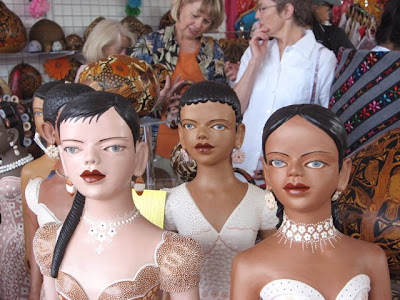 This weekend was the fifth annual International Folk Art Market in Santa Fe. Another beautiful day on Museum Hill! According to today's newspaper, the market attracted 10,000 visitors yesterday, and sales are expected to exceed last year's.
This weekend was the fifth annual International Folk Art Market in Santa Fe. Another beautiful day on Museum Hill! According to today's newspaper, the market attracted 10,000 visitors yesterday, and sales are expected to exceed last year's.I wrote extensively about the market last year and this year was equally wonderful. Bus service (from the state parking lots downtown out to the museum grounds) was significantly improved, and more buses and better traffic patterns meant shorter waits and happier customers! (I love it when something doesn't go that well, and people actually pay attention and fix the problem next time around!)
 This year's market included folks from countries not previously represented, including Mongolia, Rwanda, Kenya, and El Salvador. According to the market brochure, artists are able to "participate in a series of pre-market workshops on sales, pricing, packaging, and marketing, with a new focus on Internet marketing."
This year's market included folks from countries not previously represented, including Mongolia, Rwanda, Kenya, and El Salvador. According to the market brochure, artists are able to "participate in a series of pre-market workshops on sales, pricing, packaging, and marketing, with a new focus on Internet marketing."In addition, the market has created an internship program that this year trained four African women to lead markets in their own countries. The women are discussing the possibility of collaborating on a combined southern African market.
The market estimates that an average of $15,000 goes home with each artist or coop represented. Surveys show that profits from the market have paid for clean water, teachers and school supplies, plows and goats, buildings and soccer uniforms.
This year's purchases included two Ecuadorean beaded collars made by Fundación Warmipak Wasi, a women's cooperative of Saraguros in highland southern Ecuador.

According to their handout, the Saraguros are "descended from the Incas and are characterized by distinctive clothing and cultural traditions. They grow most of their own food . . . and herd cattle to support their daily life. But the 21st century requires that they also earn money to pay for their family needs and the education of their children. Warmipak Wasi is the Kichwa rendering of The Women's House or Casa de la Mujer. This is a shelter home for abused women from the Saraguro area, and offers services to women of all origins: indigenous, white, and mestizo. . . . Many of the women who come to the shelter learn to support themselves through the making of embroidered blouses and beadwork pieces worn traditionally by indigenous women."
 Flor Maria Cartuche, whose picture is shown here, is representing the cooperative at this year's market. She designed and sold bead collars to help fund her college education, and is now studying law.
Flor Maria Cartuche, whose picture is shown here, is representing the cooperative at this year's market. She designed and sold bead collars to help fund her college education, and is now studying law.I also purchased two Uzbek pottery pieces which are made in the village of Rishtan from local clay. According to the market brochure, these blue
 ceramics "have been famous for centuries. Forms are made on a foot-kicked pottery wheel, then hand painted and glazed with metal oxide. When the collapse of the Soviet Union closed the local factory in 1998, Rustam Usmanov,
ceramics "have been famous for centuries. Forms are made on a foot-kicked pottery wheel, then hand painted and glazed with metal oxide. When the collapse of the Soviet Union closed the local factory in 1998, Rustam Usmanov,  who designed patterns there, continued production in his home workshop. . . . Usmanov and his workers combine traditional forms and designs with original shapes and motifs. His work is exhibited at the Hermitage Museum."
who designed patterns there, continued production in his home workshop. . . . Usmanov and his workers combine traditional forms and designs with original shapes and motifs. His work is exhibited at the Hermitage Museum."My final purchase was another oil drum sculpture made by artist Winzor Gouin. I wrote about Winzor in last year's post; this year I purchased three diving mermaids--I plan to hang them over my bathtub so they look like they're diving in!

Photo Credits
I loved the Brazilian dolls (note in the photo at the top of this entry that the three women are black, white, and indigenous!) but they were out of my price range. Maybe another year!
The second photo is a small section of a large silk rug which was on display.
1 comment:
Hi. Can you tell me where to find the dolls at the top of the post? and the man who made the mermaid art?
thanks!
madgeo@comcast.net
Post a Comment